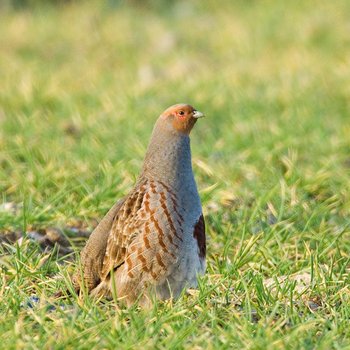

Grey Partridge
- Once one of the most familiar birds of the British countryside, numbers have declined by as much as 80% in the last 30 years.
- Though now known as the grey partridge, it is often still called the English partridge or just the partridge.
- Where this bird has been introduced into North America is it generally known as the Hungarian partridge, reflecting the source of the stock birds.
- Few birds have been as intensively studied as this, but despite our detailed knowledge of its requirements, it has proved impossible to reverse its decline.
- Ironically, the only thriving populations in England today are to be found on shooting estates where the birds are carefully looked after and ground predators controlled.
- Grey partridges are remarkably adaptable, and can be found from coastal dunes to the edge of moorland.
- The cock can be readily identified by the chestnut horseshoe mark on his chest. Some females also carry a similar mark, but it is never as obvious.
- Partridges form pairs early in the year, and these birds will stay together until the autumn.
- Partridges lay the biggest clutches of any birds, with 14 to 15 eggs usual, and even bigger clutches often recorded.
- Only the female incubates the eggs, but the male is invariably close by.
- Both sexes are attentive parents, and where predators aren’t a problem it’s not unusual for all the chicks hatched to be reared.
- Cock grey partridges can be remarkably brave (or foolhardy) in defence of their young, and have been recorded flying at stoats, weasels and even humans.
- The young can feed as soon as they leave the nest, and are capable of their first proper flight at 15 days.
- Young chicks require a high proportion of insects in their diet: it is the lack of insects in the modern countryside that has led to the birds’ widespread decline.
- They are highly social birds, and after breeding it’s quite normal for two or even three families to join together to form sizeable coveys of 20 or more birds.
- These coveys will stay together throughout the autumn and winter, not breaking up until the birds start to form pairs in early January.
- The distinctive rasping call of the grey partridge, invariably uttered when the birds are flushed, is the easiest way to tell a grey from a red-legged partridge.
- Grey partridges also call at both dawn and at dusk, making it easier to locate these otherwise beautifully camouflaged birds.
- Once the most popular sporting bird in Britain, very few estates now shoot greys, concentrating instead on red-legs, which are much easier to rear in captivity.
- The grey partridge still has the reputation for being the finest eating of all British gamebirds.
- They are highly sedentary birds, seldom moving far from where they hatched. In contrast, hand-reared birds released for shooting seldom stay in the release area for long.

